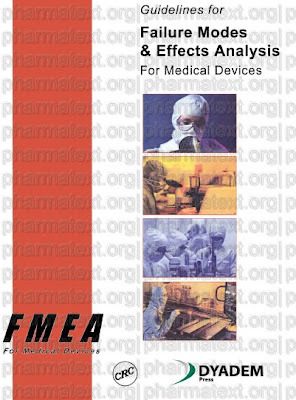Guidelines for Failure Modes and Effects Analysis for Medical Devices
 Challenged by stringent regulations, vigorous competition, and liability lawsuits,
Challenged by stringent regulations, vigorous competition, and liability lawsuits, Guidelines for Process Hazards Analysis (PHA, HAZOP), Hazards Identification, and Risk Analysis
 This unique manual is a comprehensive, easy-to-read overview of hazards analysis as it applies to the process and allied industries. The book begins by building a background in the technical definition of risk, past industrial incidents and their impacts, ensuing legislation, and the language and terms of the risk field. It addresses the different types of structured analytical techniques for conducting Process Hazards Analyses (PHA), provides a "What If" checklist, and shows how to organize and set up PHA sessions. Other topics include layout and siting considerations, Failure Modes and Effect Analysis (FMEA), human factors, loss of containment, and PHA team leadership issues.
This unique manual is a comprehensive, easy-to-read overview of hazards analysis as it applies to the process and allied industries. The book begins by building a background in the technical definition of risk, past industrial incidents and their impacts, ensuing legislation, and the language and terms of the risk field. It addresses the different types of structured analytical techniques for conducting Process Hazards Analyses (PHA), provides a "What If" checklist, and shows how to organize and set up PHA sessions. Other topics include layout and siting considerations, Failure Modes and Effect Analysis (FMEA), human factors, loss of containment, and PHA team leadership issues.Practical Design Control Implementation for Medical Devices

Bringing together, for the first time, the concepts of design control and reliability engineering, Practical Design Control Implementation helps you face the challenge of designing and developing products that comply with regulatory requirements and fulfill customer expectations. Written with all levels of management and technical personnel in mind, the authors demonstrate how successful design control implementation can result in fewer customer complaints and medical device reports, more satisfied customers, and faster time-to-market. Part One focuses on the practical aspects of design control implementation for medical devices. The fundamental concepts of design control are not new. What is new is the adoption by the FDA of these principles and their consequent enforcement. Also new to the medical device industry are the different technical concepts, tools, and techniques necessary to implement design control. In this section, each chapter provides practical advice and insight on the required FDA design control elements. Part Two explores the reliability of medical devices and how design control can influence that reliability. The book presents easy to understand examples of typical product design and development phases with the corresponding reliability and risk analysis tools such as failure modes and effects analysis (FMEA), hazard analysis, reliability planning, reliability prediction, design verification, and validation. The authors discuss the inter-relatedness of reliability engineering and design control and apply the concept to medical device design. Providing common sense explanations and guidance, Practical Design Control Implementation helps readers successfully execute design control and reliability engineering procedures that not only meet the FDA guidelines but also meet or exceed customer expectations.


0 comments:
Post a Comment